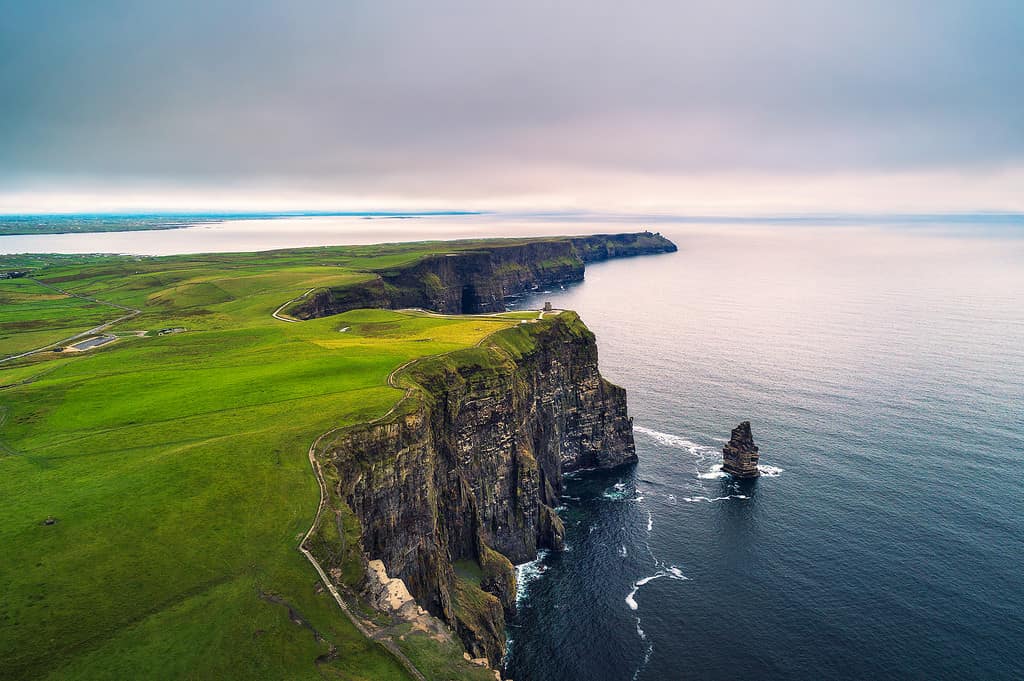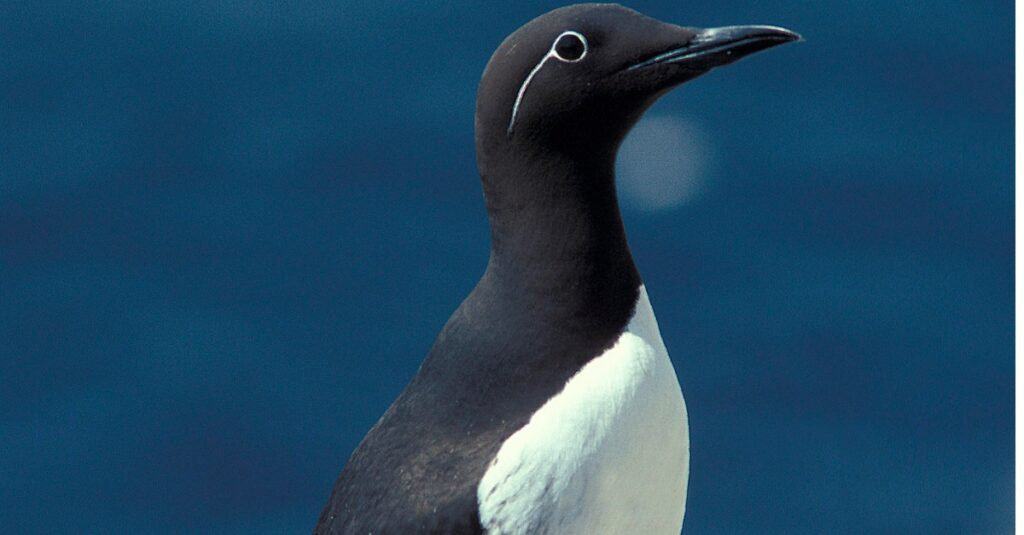In the late 1980s, a fantastic movie about a boy, his grandfather, and a storybook about true love took the world by storm. The Princess Bride, starring Cary Elwes, Robin Wright Penn, Andre the Giant, Billy Crystal, and more, told a swashbuckling tale of “fencing, fighting, torture, revenge, giants, monsters, chases, escapes, true love, [and] miracles,” as described by the grandfather in the movie.
Though shooting on location was relatively new to the movie industry in 1987 (with some of the first on-location movie filming happening in the late 1960s), film crews traversed England and Ireland to get the best shots for the movie.
Keep reading to discover the exact locations of The Princess Bride’s filming, find interesting facts about the flora and fauna of each place, and considerations for visiting.
Where Was The Princess Bride Filmed?

Buckinghamshire lent one location to the movie — the forest after the titular characters escape from the dreaded Fire Swamp.
©JohnMcDonald/Shutterstock.com
Director Rob Reiner chose to film the movie in seven specific locations in England and Ireland, including:
- Burnham Beeches (Buckinghamshire), for the forest in which Westley and Buttercup encounter Prince Humperdinck and his men after emerging from the Fire Swamp.
- Lathkill Dale (Derbyshire), for the Battle of the Wits scene between Vizzini and the Dread Pirate Roberts.
- Cave Dale (Derbyshire), for the particular scene of Westley rolling down a hill saying “As you wish.”
- Bradley Rocks (Derbyshire), for the farm where Buttercup and Westley meet.
- Cliffs of Moher (Ireland), for the Cliffs of Insanity.
- Haddon Hall (Derbyshire), for Prince Humperdinck’s castle in the country of Florin.
- Penshurst Place (Kent), for the duel between Inigo Montoya and Count Rugen, the six-fingered man who killed his father.
A few other scenes were filmed in Shepperton Studios, like the Fire Swamp, the shrieking eels scene, Miracle Max’s hut, and the framing story scenes between the grandfather and grandson.
Best Time to Visit Derbyshire
Avoid the summer crowds of Derbyshire and visit in Autumn. This time frame ensures the best view of the Peak District, a popular place for local and international visitors. Derbyshire also has mild weather in the autumn. Though not as hot as the summer, the weather remains warm and pretty dry for hiking, pumpkin picking, and sightseeing in the region. As the leaves change colors in fall and cave exploration is popular, autumn provides the best weather coupled with the lowest crowds!
Best Time to Visit Buckinghamshire
Called “Bucks” by the locals and enamored visitors, Buckinghamshire is best visited in the summer months specifically for its tourable countryside. The nationally-recognized buildings and gardens like Chequers Court, Bletchley Park, and Stowe Gardens are a nature lover’s dream. Not to mention, some of the region feels like it stepped right out of a Jane Austen novel — because it either inspired a place in her stories or has been used as a filming location for recent movie adaptations of her books.
Best Time to Visit Kent
While Kent is a year-round destination with the best of both worlds — beaches and moors — it’s a great place to visit in July and August to ensure you can actually enjoy both settings!
Like many other English towns, Kent becomes rainy during mid-fall and early winter. So, visiting Kent in July and August means you’ll experience the best weather as you explore the countryside, coastline, and cityscapes. While you will battle peak season crowds, chances are that you’ll have a great day to see Canterbury, Dover Castle, and Kent Downs.
Best Time to Visit Ireland

The Cliffs of Moher are in County Clare along the Wild Atlantic Way.
©miroslav_1/iStock via Getty Images
If you’re interested in specifically visiting the Cliffs of Moher (The Princess Bride’s Cliffs of Insanity), attempt to travel to Ireland between April and September. The beginning and end of this time frame won’t be as warm — and may be a little wet thanks to Ireland’s frequent rain storms — but it will provide the best weather compared to other months. Even the Cliffs of Moher’s website states that weather on the cliff face remains highly unpredictable, so you may get fog and sunshine within a several-hour visit.
Flora of Derbyshire
In the mid-1990s, the Derby City Council gathered to create a Biodiversity Action Plan for Derbyshire that ensured the conservation of its native and non-native plants. Across Derbyshire’s woodlands, grasslands, heathlands, brownfields, and wetlands, you’ll find a plethora of interesting flora. Some of the most common trees you’ll find in Derbyshire are oaks, beeches, ash trees, and birchwoods, while the wildflowers around the area include orchids, parsnips, violets, and chamomile.
Flora of Buckinghamshire
Bucks has rolling hills and neatly manicured lawns that allow a variety of wildflowers to grow. Like the wildflowers of Derbyshire — different species of orchids, violets, and parsnips — the region has its own unique catalog of blooms. You can expect to encounter brambles, the round-leaved sundew, and even Devil’s-bit scabious.
As for trees and shrubs, much of the same from Derbyshire grows in Bucks. However, Bucks also grows bilberry, monkey-puzzle, and spindle trees.
Flora of Kent

In Kent, you’ll find wild parsnips blooming across the grasslands.
©R. A. Nonenmacher / CC BY-SA 4.0 – License
Like Derbyshire and Buckinghamshire, the wildflowers of Kent are similar. In addition to orchids, violets, and parsnips, Kent’s lands grow the unique opposite-leaved golden saxifrage, curled dock, and pasqueflower. Native trees in the area include a Holm oak, the horse chestnut, several species of elm, and the elder tree.
Flora of Ireland
The shamrock remains a cultural symbol of Ireland, but it’s not the only plant from the island nation. Dozens of other species of flowers bloom in Ireland, including:
- The bog rosemary.
- Sheep’s-bit.
- Cowslips.
- Gorse.
- Primrose.
Did you know that Ireland also has 28 species of native trees and shrubs? They include ivy, the self-sustaining climbing shrub that many choose to use for privacy screening; scots pine, which is all but extinct except for bog stumps and transplanted trunks; willow, with several different varieties throughout the country; and wych elm, which is mostly found in glens.
Fauna of Derbyshire

Shrews are one of Derbyshire’s native land mammals.
©iStock.com/Imagesines
Derbyshire’s mammalian wildlife consists mainly of bats, voles, deer, and shrews. These animals, well-suited to the habitats Derbyshire provides, rely on the region’s flora (and locals’ gardens) to survive. Birds in Derbyshire fly in droves to the area, with dozens of species of divers, seabirds, waterfowl, birds of prey, larks, sparrows, swallows, warblers, and finches making their nests above the branches of Derby.
Fauna of Buckinghamshire
Buckinghamshire is home to similar mammals and birds as Derbyshire and its invertebrate population is healthy, too. Dozens of spiders crawl around the forests, glens, and homes of those in Buckinghamshire. Some of the most interesting types of spiders in the region include the flower crab spider, the cucumber spider, the zebra spider, and the common harvestman.
Other invertebrates, like damselflies, millipedes, beetles, and moths rely on Buckinghamshire’s biodiversity to find food, make habitats, and reproduce.
Fauna of Kent
In addition to the mammals, birds, and invertebrates of the other regions, Kent contributes four different snake species to England’s districts. While in Kent, you’ll most likely encounter either a smooth snake, a slow worm, a grass snake, or an adder. Sand and common lizards also scurry around the land of Kent.
Kent’s 350-mile coastline also plays host to a variety of marine animals like sea snails, sponges, squid, bivalves, and fish. Some of the most interesting are the by-the-wind-sailor, a colonial hydroid similar to the Portuguese Man O’ War; the razor shell, the easily-recognizable clam that feeds on plankton and detritus; the bloody henry starfish, which feeds on plankton and has a purple-red color; and the Thresher shark, which migrates to the UK and jumps out of the water it catches its prey.
Fauna of Ireland

Tourists to the Cliffs of Moher mistake guillemots for penguins, but they are very different species!
©iStock.com/slowmotiongli
When visiting the Cliffs of Moher, you’re treated to an adorable array of puffins and other semi-aquatic animals like basking sharks, kittiwakes, razorbills, and dolphins.
The seabirds residing near the Cliffs, including kittiwakes, razorbills, and guillemots, make their rests around the Great Sea Stack. Guillemots remain the most pervasive bird colony near the Cliffs, and they are sometimes mistaken for penguins by visitors.
When it comes to land mammals, you’ll see badgers, rabbits, and the rare stoats scurrying around. They mostly keep to themselves, and the best way to see land mammals — or the seabirds — is to ride a ferry around the Cliffs for a whale’s-eye view.
Timeless Beauty in England and Ireland
The timeless movie The Princess Bride owes its success, in part, to the incredible settings that lent their location to the film. Between the Cliffs of Moher and Derbyshire’s Peak District, the regions of England and Ireland created the magic, miracles, and swashbuckling adventure of the movie. When you visit, let yourself sink into the magic of the areas and make your own fairytale amid the cliffs, estates, and wooded areas.
The photo featured at the top of this post is © VictorHuang/iStock / Getty Images Plus via Getty Images
Thank you for reading! Have some feedback for us? Contact the AZ Animals editorial team.







